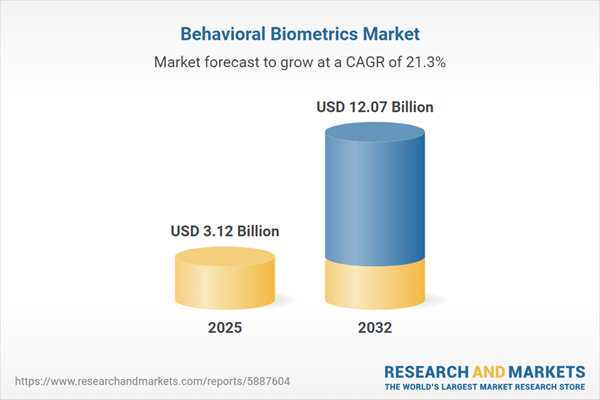Speak directly to the analyst to clarify any post sales queries you may have.
As organizations worldwide step up digital transformation initiatives, the behavioral biometrics market has become central to modern enterprise security, regulatory compliance, and frictionless user authentication. Senior leaders increasingly leverage behavioral analytics to combat emerging threats while navigating evolving global standards.
Market Snapshot: Growth and Outlook of the Behavioral Biometrics Market
The behavioral biometrics market is witnessing robust expansion as enterprises invest in digital infrastructure and address heightened cybersecurity risks. Current demand is propelled by organizations prioritizing secure, seamless user experiences and adapting to shifting risk landscapes. Artificial intelligence and machine learning underpin the effectiveness of behavioral biometrics solutions, driving superior anomaly detection capabilities. Leading sectors—finance, healthcare, government, and technology—accelerate their adoption to reinforce compliance obligations and streamline digital channel operations. Adaptive authentication, previously a cutting-edge feature, is now integrated as a baseline security requirement across digital platforms to support ongoing regulatory and usability needs.
Scope & Segmentation: Behavioral Biometrics Market
- Authentication Types: Includes gait recognition, keystroke dynamics, mouse and signature dynamics, and voice recognition, enabling organizations to assess user identity across both desktop and mobile platforms. These tools prove essential in industries with sensitive data protection and compliance mandates.
- Solution Components: Managed services, professional advisory solutions, standalone analytics, and integrated software options allow for tailored deployment. This flexibility supports diverse organizational needs, ensures smooth onboarding, and simplifies integration into established IT systems.
- Deployment Modes: Hybrid, private cloud, public cloud, and on-premise models give businesses choices to align security strategies with specific operational requirements and to manage modernization timelines.
- End-User Industries: Banking, insurance, government, healthcare, IT, telecommunications, and retail sectors consistently implement robust identity assurance and process stability to satisfy customer and regulatory demands. Each industry segment brings unique workflow expectations that influence deployment scope.
- Applications: Continuous authentication, fraud detection, and one-time authentication utilize behavioral analytics for risk assessment and transaction security. These applications are adaptable to the complexity and diversity of modern enterprise workflows.
- Regional Coverage: The market maintains a presence across the Americas, Europe, Middle East & Africa, and Asia-Pacific. Adoption varies by readiness initiatives and regulatory alignment, particularly in the United States, Germany, China, India, and Australia, reflecting local technology deployment trends.
- Leading Companies: BioCatch Ltd., Nuance Communications, Daon, BehavioSec Holding AB, Plurilock Security, TypingDNA, Callsign, iProov, Zighra, and SecuredTouch drive innovation and set industry standards for behavioral biometrics solutions.
Key Takeaways: Strategic Insights for Decision-Makers
- Behavioral biometrics reinforce adaptive authentication, equipping organizations to monitor digital interactions for anomalies and quickly respond to potential security incidents.
- Artificial intelligence and machine learning usage in authentication platforms support scalable and flexible deployment in complex digital ecosystems, adapting to new patterns and threats as they arise.
- Diverse deployment options across cloud and on-premise environments allow organizations to adjust their authentication infrastructure as compliance needs and operational demands evolve.
- Seamless integration across both legacy and modern IT environments enables comprehensive digital identity assurance, maintaining consistent user experiences and security postures during system upgrades.
- Applying behavioral biometrics helps organizations achieve an effective balance between stringent security controls and ease of use, supporting operational reliability while improving digital trust.
- Ongoing market activity from leading vendors enables organizations to stay proactive in the face of changing regulatory requirements and technology trends, ensuring resilience and preparedness.
Tariff Impact: U.S. Tariff Adjustments and Supply Chain Resilience
Recent adjustments to U.S. tariffs have introduced new challenges in acquiring hardware and sensor components necessary for behavioral biometrics deployments. In response, companies are enhancing supply chain resilience by diversifying vendor relationships, winding down hardware dependency, and prioritizing software-centric authentication approaches. These strategic actions ensure organizations sustain secure authentication and mitigate international logistics disruptions.
Methodology & Data Sources
This analysis consolidates secondary market research, direct interviews, and targeted surveys with technology and procurement officers. Scenario planning and independent third-party validation were employed to ensure comprehensive insight and reflect practical deployment realities in the behavioral biometrics sector.
Why This Report Matters: Behavioral Biometrics Market
- Clarifies the impact of regulatory shifts, technological advances, and new operational needs on global behavioral biometrics market growth and investment.
- Enables senior decision-makers to assess security risks, strategically allocate resources, and build resilient digital operations across varied organizational contexts.
- Provides actionable guidance for designing security architectures that support adaptable, compliance-oriented frameworks responding to both sector-specific and global mandates.
Conclusion
Behavioral biometrics provides organizations with scalable authentication and advanced digital security. This approach strengthens operational confidence and maintains stability throughout dynamic digital business environments.
Additional Product Information:
- Purchase of this report includes 1 year online access with quarterly updates.
- This report can be updated on request. Please contact our Customer Experience team using the Ask a Question widget on our website.
Table of Contents
3. Executive Summary
4. Market Overview
7. Cumulative Impact of Artificial Intelligence 2025
Companies Mentioned
The companies profiled in this Behavioral Biometrics market report include:- BioCatch Ltd.
- Nuance Communications, Inc.
- Daon, Inc.
- BehavioSec Holding AB
- Plurilock Security Inc.
- TypingDNA, Inc.
- Callsign Ltd.
- iProov Ltd.
- Zighra, Inc.
- SecuredTouch, Inc.
Table Information
| Report Attribute | Details |
|---|---|
| No. of Pages | 181 |
| Published | November 2025 |
| Forecast Period | 2025 - 2032 |
| Estimated Market Value ( USD | $ 3.12 Billion |
| Forecasted Market Value ( USD | $ 12.07 Billion |
| Compound Annual Growth Rate | 21.3% |
| Regions Covered | Global |
| No. of Companies Mentioned | 11 |









